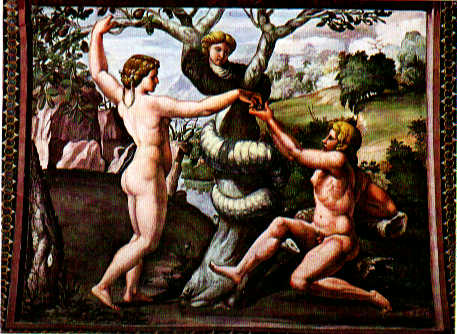
Sexual Desire
Contrary to the modern stereotype that views males as more susceptible to sexual desire than females, during the Middle Ages women were often seen as much more lustful than men. General opinion held that men were more rational, active creatures and closer to the spiritual realm, while women were carnal by nature and thus more materialistic. In the Decameron there are many examples of lusty women with insatiable desires. The nuns in III.1 ("whereas a single cock is quite sufficient for ten hens, ten men are hard put to satisfy ten women," 198), Alibech, who develops a taste for "putting the devil back in Hell" in III.10, and the wife of Calandrino ("this woman's going to be the death of me... with her insatiable lust..." 661) in IX.3 are just a few examples.
Isidore of Seville believed that man derived his name (vir in Latin) from his force (vis), just as woman acquired her name (mulier) from her softness (mollities), and he considered women to be "very passionate... more libidinous then men." According to Jerome, "...women's love in general is accused of ever being insatiable; put it out, it bursts into flame; give it plenty, it is again in need; it enervates a man's mind, and engrosses all thought except for the passion which it feeds" (Salisbury, 86). This second quote touches on the popular belief that all women, as descendants of Eve, were temptresses and thus the source of Original Sin, which had become inextricably linked to sexual desire by the Church Fathers (Richards, 25).
Although popular opinion saw women as sexually insatiable, it was also considered "natural" for women to take on a more submissive role during sexual intercourse. The same female "softness" that indicated the presence of passion also led to an innate passivity, according to most theologians and canonists. According to Joyce E. Salisbury, author of "Gendered Sexuality," "to take one's passion actively was the manly way" (85). Women were expected to be shy about sexual matters, and it was considered men's obligation to interpret the "signals" sent out by their wives in order to be able to satisfy them adequately. In addition, this focus on the male as the "active" partner during sex had a significant influence on contemporary views concerning the acceptability of certain sexual positions.
There were, on the other hand, some more "modern" opinions on the subject. For example, religious thinker Hildegard of Bingen did not subscribe to the notion that women possessed greater sexual desires than men. However, she did agree to the distinction between male action and female inaction during sex: "[woman] is like a threshing-floor pounded by his many strokes and brought to heat while the grains are threshed inside her" (Salisbury, 94). Salisbury observes that, despite Hildegard and others like her, it was still widely believed that that women required more than men did to be satisfied (86). (Interestingly, most authors of the time were genuinely convinced that women experienced greater pleasure during the sex act.) No doubt troubled by the thought that the innate desires of unmarried daughters might lead to trouble, royal families often locked up their young girls, out of sight and hopefully beyond the reach of temptation (Brundage, 428).
(A.M.S.) Boccaccio, Giovanni. The Decameron. Trans. G. H. McWilliam. New York: Penguin, 1972.
Brundage, James A. Law, Sex, and Christian Society in Medieval Europe. Chicago: The University of Chicago Press, 1987.
Richards, Jeffrey. Dissidence and Damnation: Minority Groups in the Middle Ages. New York: Routledge, 1994.
Salisbury, Joyce E. "Gendered Sexuality." Handbook of Medieval Sexuality. Vern L. Bullough and James A. Brundage, eds. New York: Garland, 1996, pp. 81-102.